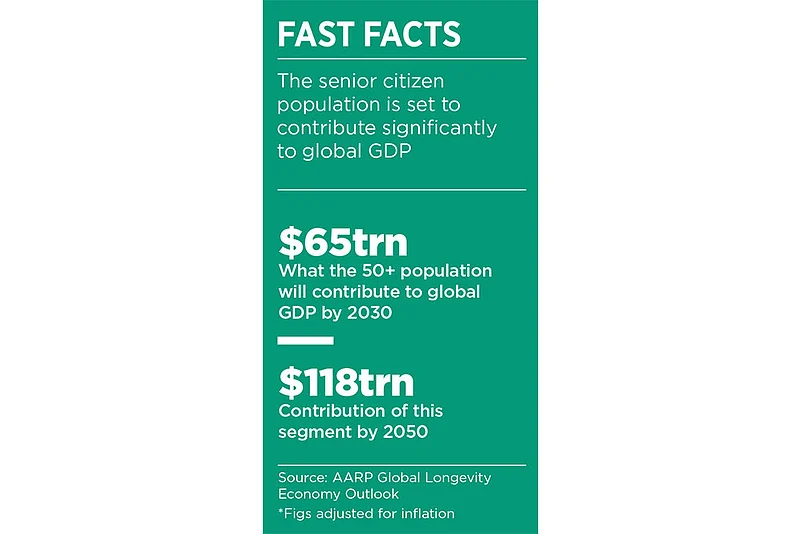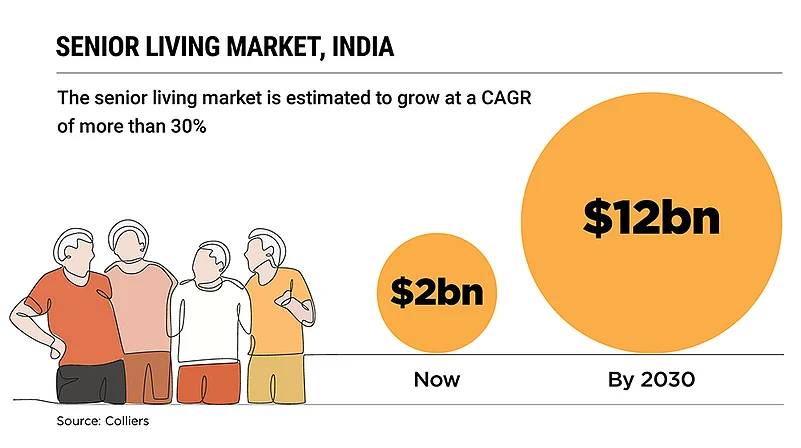A callow 20-something Paul McCartney thought that the 60s were a time for knitting “a sweater by the fireside” and “doing the garden, digging the weeds” (“When I’m 64”, Sgt Pepper’s Lonely Hearts Club Band). Ironically at 82, McCartney is doing just the opposite. Instead of staying at home and playing with grandchildren, he is busy touring to packed auditoriums.
McCartney is not alone in leading an active life even after becoming a senior citizen. Gone are the days when turning 60 meant renouncing worldly pleasures and withdrawing into a shell. Take the example of Subhasree Tagore. The 76-year-old former professor and an avid traveller has been to Kunnur, the Stans and even to faraway New Zealand in the past few months.
“I love travelling. As a retired professor I now have the time and money to indulge myself. A lot of places now have provisions for elderly people. That’s a bonus,” she says.
Beyond pursuing leisure activities, many senior citizens continue to work. Delhi-based VP Gupta retired as registrar from the All India Institute of Medical Sciences (AIIMS) in 2012 when he turned 60. The very next day he joined a private university. At 72, he is still working; in fact, he earned a PhD when he was 65.
“My grandchildren are now on the verge of joining the workforce, but I don’t want to retire,” Gupta told Outlook Money, our sister publication.
Never Too Old
Most senior citizens after retirement either receive pension or have a sizeable nest egg in place, says Tagore. That plus enough free time and fewer commitments are catalysts for travel or pursuing their passions.
A 2024 paper Senior Care Reforms in India: Reimagining the Senior Care Paradigm by NITI Aayog notes that “by 2050 one in every four Indians will be a senior citizen, it will be equal to the population of the US for the industry in the form of a ‘silver economy’.”
Silver economy is the phrase used to describe production and consumption of goods and services for the 50+ cohort. Colliers, an investment management company, estimates the senior living market to grow at a compound annual growth rate (CAGR) of more than 30% from $2–3bn currently to approximately $12bn by 2030.
The United Nations World Population Prospects 2024 states that the Indian population, the largest in the world, will continue to grow till 2062 before it begins to decline. The share of the elderly as part of the population will keep rising.
This has given a fillip to the seniors-centric service sector, which has come into its own primarily due to the number of seniors in the country and their relative wealth vis-a-vis millennials or Gen Z.
Delhi-based nonprofit Agewell Foundation, in a 2018 study titled Changing Patterns of Income and Expenditure of Older People in India, said that due to the change in financial status and enhanced independence of elderly belonging to the middle, upper-middle and upper classes, their position in financial markets has changed dramatically. “Today, they can be observed to be active buyers as well as consumers of various products and services and embarking on other financial activities,” it said.
According to the United Nations Population Fund’s India’s Ageing Report 2023, 149mn people fell in the age bracket of 60 and above in 2022, “This unprecedented rise in the ageing population will have significant implications for health, economy and society in India,” it said.
In Good Health
The healthcare-related services sector is an obvious gainer in the silver economy. The NITI Aayog paper quoted earlier states that health-related wearables have a burgeoning market for the elderly population. Data supports the paper as Grand View Research states the global wearable devices market is projected to grow to $87.77bn by 2027.
Elders-specific wearables are already available in the market, such as smartwatches and fitness trackers with features like heart rate monitor, blood pressure monitor, fall detection sensors, GPS trackers and emergency response systems that can nudge emergency responders or caregivers in case of a medical emergency.

Anil Jain, 73, a Delhi-based businessman says, “I use my watch to track heart health and recovery during my exercise, which includes swimming, walking and yoga. By monitoring daily exercise minutes and calories burned, I maintain control over my health.”
Start-ups that cater exclusively to older people are mushrooming, offering healthcare, convenience and recreation services. Yodda, an elder care service provider, is one such founded in 2021. It provides services like healthcare, emergency care, chronic disease management and convenience services including assistance in banking, insurance, grocery or food delivery.
Then there are other start-ups working in the active ageing aspect of senior care like GetSetUp, a community-driven online platform that offers classes on financial planning, health and enrichment and fosters connections among older adults.
“Different types of start-ups focusing on different elements of ageing are set to come up. The most prominent growth will be seen in assisted and active living communities. Geriatrics is another segment which can witness immense growth including palliative care and hospice care,” says Yodda founder Tarun Sharma.
“The industry is nascent,” points out Deval Delivala, GetSetUp co-founder, adding that there is an opportunity in supporting seniors to become digitally literate. “In today's connected world, they need to be a part of the digital ecosystem to avail services meant for them,” she says. “There are many companies that are building AI-driven solutions for seniors.”
There are a total of 130 companies engaged in senior care with a $50.7mn total funding amount as of September 2024, according to Tracxn, which tracks start-up data.

What the Doctor Ordered
A common issue faced by the elderly is moving from one hospital to another for diagnostics. Now this market is being tapped by start-ups visiting patients’ houses and offering a plethora of spot tests and online reports.
Clinics on Cloud, a health-tech company, has installed Health ATMs in hospitals and healthcare centres that offer routine health checks and diagnostic tests.
Abhay Agarwal, founder and chief executive of Clinics on Cloud, says that senior citizens often face significant challenges in accessing healthcare due to mobility issues and the complexity of healthcare systems.
“Health ATM facilities aim to alleviate some of these challenges by providing essential medical services closer to where senior citizens live. These facilities offer routine health checks, diagnostic tests and telemedicine consultations. This approach helps reduce the need for travel,” he says.
There are a total of 130 companies engaged in senior care with a $50.7mn total funding amount as of September 2024
Experts point out that the health insurance segment for the elderly has not been fully explored by insurance companies despite the health insurance sector coming of age in India. Recently, the Insurance Regulatory and Development Authority of India (IRDAI) amended the health insurance rules to favour the silver economy. The age ceiling of 65 years for getting health insurance has been removed, which means that now seniors have more options to choose from. This has led to a new market for insurance companies to explore.
The waiting period for pre-existing diseases in insurance plans has been reduced from four to three years, which can motivate more people to opt for health insurance and, thus, increase insurance penetration in the senior citizen segment, says Siddharth Singhal, head of health insurance at Policybazaar.com, an online insurance platform.
“Previously, these plans had a mandatory co-payment of 20% for people entering at 60 years and above. Co-payment has now become optional. People can choose to remove the co-payment clause by paying extra premium or increase it to get discounts on their health insurance premiums. These initiatives ensure the needs of India’s ageing population are fulfilled,” he says.
Living with Peers
Another space that is likely to boom in the silver economy is assisted living. “In 2024, the estimated demand for assisted living stands at approximately 0.35mn individuals. Over the next five years, this demand is projected to increase to 0.5mn, reflecting the growing need for specialised care and support services among the elderly,” says a 2024 report published by real estate consultant CBRE South Asia titled Golden Opportunities from the Silver Economy.
Dipankar Sanyal, 73, a scholar and researcher has been living at Antara Senior Living in Dehradun for the past five years. “Life at Antara keeps us busy but at our individual relaxed pace, giving us the freedom to explore our interests,” he says.
"Older travellers, especially those aged 60 and above, are increasingly seeking personalised, health-focused and culturally immersive travel experiences" Pratik Mazumder, CMO, Mahindra Holidays and Resorts
This sector has shown such promise that it is attracting investments from real estate developers and private equity firms through strategic partnerships with healthcare groups. “These investments are specifically earmarked for purposes such as the development of new projects, acquisition of land and enhancement of infrastructure,” says Anshuman Magazine, chairman and chief executive, India, Southeast Asia, West Asia and Africa, of CBRE.
Closely related to assisted living having elements of leisure is the evolution of the elderly segment in the travel and tourism industry. “People in the travel industry have become quite conscious of the fact that elderly people are travelling more frequently. They [travel professionals] keep in mind the requirements of ageing senior citizens,” Tagore, the former teacher, says.
“The market for the silver economy in the travel segment is substantial and growing. By 2050, India is expected to have 17% of the world's elderly population, making it the fastest-growing silver economy globally. This segment in India is already growing by 17% YoY [year-on-year], and by 2030, we are expecting 7mn outbound travellers from India in the category,” says Pratik Mazumder, chief marketing officer at Mahindra Holidays and Resorts.
He adds that with more disposable income in hand and time to travel, older travellers, especially those aged 60 and above, are increasingly seeking personalised, health-focused and culturally immersive travel experiences. And these keywords define the rise and sustenance of silver economy in India.
True, India’s senior citizens are not rockin’ like Sir Paul, but they are groovin’ for sure.
(With additional reporting by Nandini Keshari)











 Just one email a week
Just one email a week